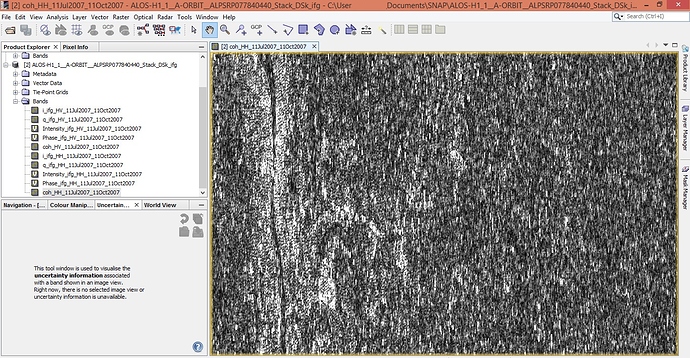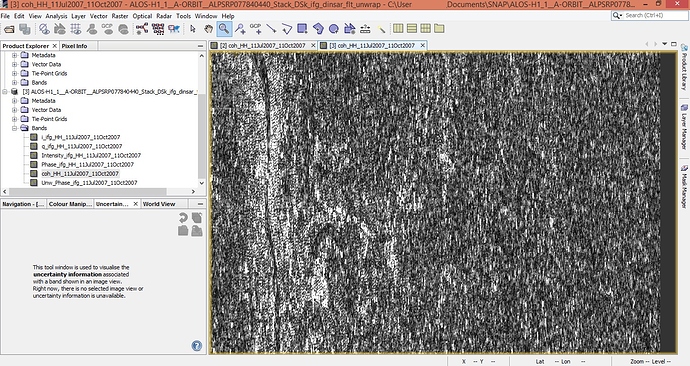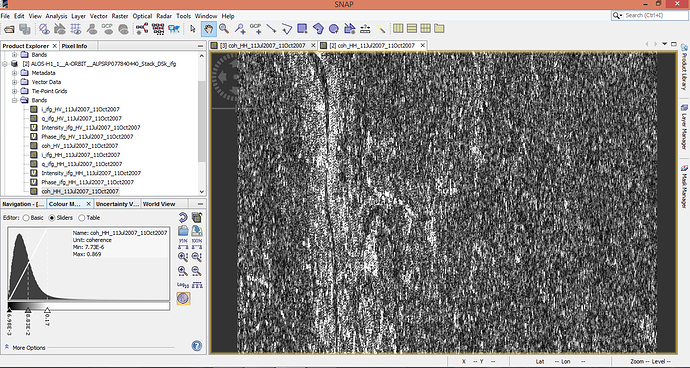The interferogram looks like it’s almost only noise. Unwrapping noise can produce a “result” but it will not be useful for anything…
Hi @draco
I am not sure but the wrapped interferogram you showed seems to have still the reference phase of the ellipsoid to be removed.
Had you remove it? Or is it pure interferogram (phase difference between master and slave)?
Could you also show the coherence you got?
@ABraun I again forgot about the coherence. Well, I am trying it out. But here I have a question, there might be very minimum subsidence in this zone. Even then if it is possible to retrieve subsidence rates I have to generate it.  So how much should be the threshold?
So how much should be the threshold?
Thank you for your response. But then could you please provide some idea as to how to generate a proper result?
Thank you for your response. I followed these steps:
1.Coregistration
2.Deskewing
3.Interferogram formation
4.topographic phase removal
5.Goldstein filtering
6.Unwrapping in snaphu
7.phase to displacement
8.Doppler Terrain Correction
Of course I forgot about the coherence mask step. I am trying it now.
you can calculate the coherence at any time from the coregistered stack. No need to repeat every step. Acutually it is included in the interferogram generation.
However, there is no general threshold for valid pixels. But it is a good spatial indicator for quality.
Please have a look at mengdahl’s comments on coherent processes. The same applies for your delta: How can we calculate the volume of displaced material with displacement band(displacement_VV)?
Thank you for your advice @ABraun. I have uploaded the coherence layer from the ifg and the unwrapped image. I saw that there was a different band math for coherence in the link that you had sent before. So I thought the coh_HH…>0.2 band math should be done.
Further as per your previous post my time gap is from July 2007 to August 2007. Can you please tell me what should I do now?
can you please show the colour manipulation tab? It is important what values these patterns have. Maybe you direclty adjust the coloru slider between 0 (black) and 1 (white) so these values can be viewed in a perspective.
But based on your image I don’t have much hopes that you can do much in this area, besides trying another image pair.
PS: Coherence is based on the original image pair and doesn’t change during the processing, so it doesn’t make any difference if it is computed again after the unwrapping.
Hi @draco
In the 3. Interferogram formation, do you have selected the “Substract Flat-Earth phase” option? I guess it should be selected by default , but please check it out, just in case.
hello @mdelgado. Thank you for your response. But in my interferogram step this was selected by default. Should I uncheck it and do it again?
as you can see, nearly none of your coherence values is above 0.2. This is not enough for interferometry. As said, this only works for coherent changes, when the targets remain the same over time.
One last thing you can try is Sentinel-1 data. C band is of shorter wavelength and maybe has more suitable interaction with the surfaces in your area.
Guided tutorial on Sentinel-1 TOPS interferometry
Thank you for the help. But you see I need to study older imagery of the study area, and that is only available in the ALOS imagery. I have not been able to download the radarsat imagery although I was logged in.
And yes I noticed that you edited your post. I also edited this post 
I edited my post above. Maybe you are more lucky with Sentinel-1 data.
Sentinel is available from 2015. But older imagery available for my zone is ALOS. ERS 1 and 2 are not available either. Same with TanDEM X. Well I shall try a different pair. If I find one with good coherence I will surely revert.
So, Flat earth phase has to be selected, right? What other change can be done?
Two more possible changes/comments:
-
How is your coregistration done? Coarse+Fine+Warp?
-
From your images, are one FBS and FBD? In the past I did some interferograms with 1.1 and DORIS, and by then I had to select as slave the one with higher bandwith (if I remember properly). What I cannot remember if the images were FBS and FBD or both with the same mode.
-
It is worth trying it there is nothing else to try. If you already had it in that way, I am running out of ideas
Thank you for your response @mdelgado. Coregistration was coarse+fine. But now I am trying a Dem assisted coregisration. Trying to find out what can improve the image. And yes unfortunately both are FBD!  Should I try with a 1.5 complex?
Should I try with a 1.5 complex?
No. Interferometry should be with SLC (1.1) or level 0 if you can use ROI_PAC for example, which focuses the images.
I run out of ideas.
Let us know if you manage to solve it.


